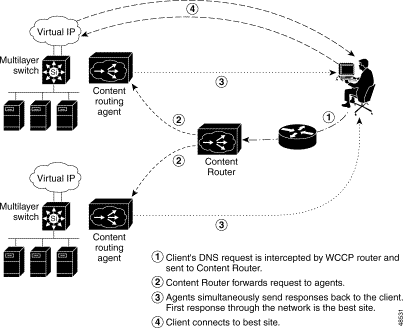|
|

Content routing routes user requests to the replicated-content site (typically a mirror site) that can serve them most quickly and efficiently. The Content Routing software, once installed and configured on a Content Router, redirects a user request to the "closest" (best) replicated-content site, based on network delay, using a software process called boomerang. The Content Routing software load balances up to 500 sites for each domain it is configured to support.
A Content Router running the Content Routing software can be deployed on a network in two different ways. It can be set up in direct mode. Or it can be set up in Web Cache Communication Protocol (WCCP) mode. Both deployments involve setting up a content routing agent at each content site within each domain you want the Content Router to support. Content routing agents are machines (such as Content Engines) that have been configured to interact with the Content Router. When configured with the Content Routing software, the Content Router can support up to 200 content routing agents.
In direct mode, the Content Router is configured as the authoritative DNS server for the fully qualified domain name being routed. For example, to route www.foo.com, the address (A) record in the primary DNS server for www.foo.com is changed to a name server (NS) record pointing to the Content Router. All requests for the IP address of www.foo.com are handled by the Content Router and its content routing agents. When a request arrives, a specific number of agents respond at exactly the same time. This is called the "DNS race" because the agent that sent the first response received is the winner of the DNS race and is therefore the site to which the user will connect. Figure 1-1 provides an overview of this content routing process in direct mode.

In WCCP mode, the Content Router works in conjunction with the access routers at the edge of the network to allow an Access Service Provider or enterprise to make DNS-based routing decisions based on the actual user request, rather than on the client DNS server. The DNS requests are intercepted by WCCP running on the access routers at the edge, and all requests are funneled to the Content Router. Any request that does not come from one of the Content Router's configured domains is passed on to the DNS server in the original request. If the request is from one of the Content Router's configured domains, the Content Router initiates the DNS race. The DNS race occurs in the same manner as described in the preceding section: content routing agents send a response at the same moment, and the first response through the network determines the site to which the user connects. Figure 1-2 provides an overview of the content routing process in WCCP mode.

Figure 1-3 provides a closer look at the first part of the content routing process, in which the Content Router determines the one-way delay it uses when sending requests to the agents. This one-way delay ensures that the agents will begin the DNS race simultaneously.

![]()
![]()
![]()
![]()
![]()
![]()
![]()
![]()
Posted: Sun Sep 29 11:01:42 PDT 2002
All contents are Copyright © 1992--2002 Cisco Systems, Inc. All rights reserved.
Important Notices and Privacy Statement.